Gojo City boasts the best persimmons in Japan
A special event full of persimmons that can only be realized locally
“Japanese cuisine is Japan’s proud food culture. Its roots are in Nara.” The “Japanese Food Pilgrimage – NARA” project plans gastronomy tourism where you can learn about the roots of Japanese food and experience the culture. Six diverse programs are being rolled out in 2023 as well.
The fourth part was a bus tour on November 23rd, with 17 guests (including 7 foreigners), to Nishiyoshino and Gojo Shinmachi, Gojo City, which boasts the best persimmon production in Japan, under fine weather. . The program includes a visit to the popular “Kaki no Sato Festival” → a persimmon harvest experience at a farmhouse restaurant in an old private house built over 150 years ago, and a lunch of seasonal vegetables prepared by local mothers → a tour of Gojo Sake Brewery → a tour of the quaint Gojo Shinmachi It’s a fascinating trip where you can experience persimmon-themed food and alcohol pairing at the popular restaurant “Genbei.”
This time, just like the “Marriage of Nara Sake and Cuisine with Nara Roots + Nara Traditional Culture Experience” held at three hotels, this time as well, materials and menus were prepared in both Japanese and English. We took care of the foreign participants by having interpreter guides simultaneously translate what the facilitator, host, and guests were saying.

The interpreter guide gives a fun lecture in the moving vehicle. My expectations for the trip grow
At 9 a.m. on November 23rd, the sightseeing bus carrying the participants and staff who had completed registration departed from Kashihara-Jingumae Station on time and headed straight for the Kakinosato Festival venue in Nishiyoshino, Gojo City. On the way, Yoko Matsumura, an English interpreter, explained to us about the spots we were going to visit on the “Persimmon Tour” while holding up the panels we had brought with us.
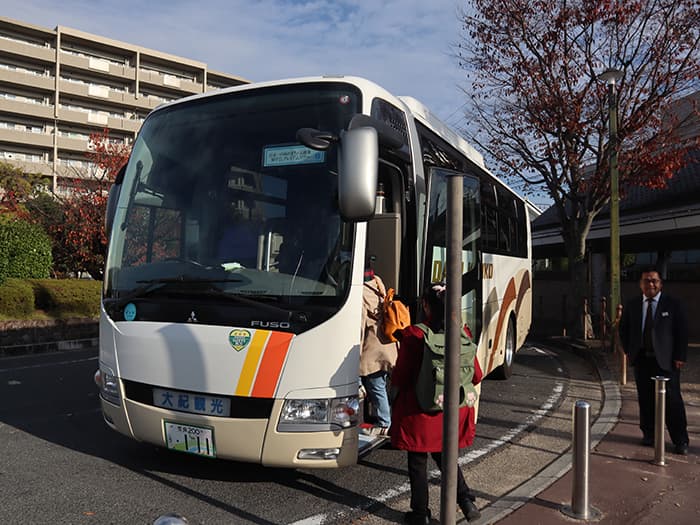
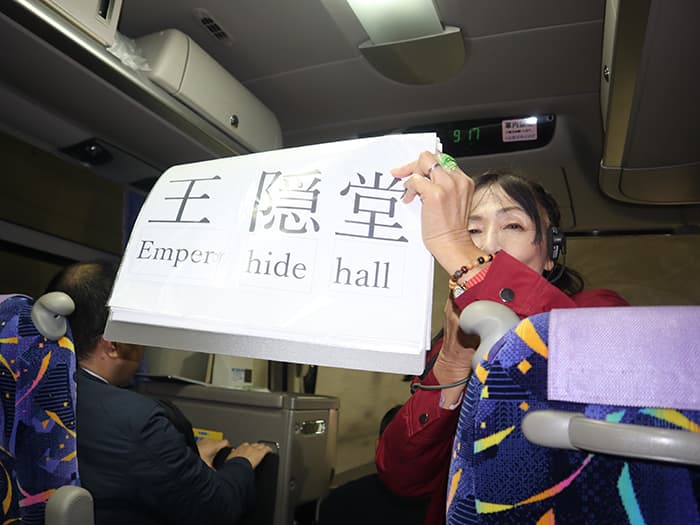
Gojo City is Japan’s number one producer of persimmons, and we stopped by the Persimmon Festival, followed by a persimmon harvesting experience at the 150-year-old old folk house restaurant, Seasonal Vegetable Restaurant Noyusha Ohindo. After that, we explained that we would have a home-cooked lunch prepared by local mothers using seasonal ingredients. The origin of the name “Ohindo” was also talked about, and everyone was surprised by its deep history (more on that later).
After lunch, the sake brewery tour included an easy-to-understand explanation of the Japanese sake manufacturing process, comparing it to wine. The participants nodded enthusiastically as they listened, and when they heard the words, “There will also be tastings,” they got a little excited. It seems that expectations for the tour have increased.
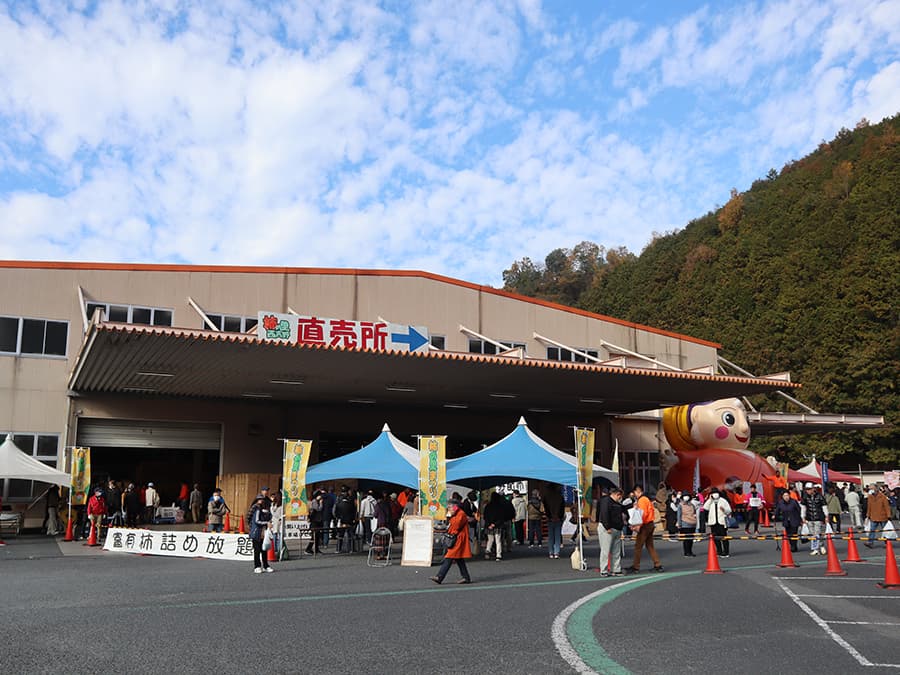
Kaki no Sato Festival is a huge turnout
Shopping for persimmons and processed products
The “Kaki no Sato Festival” is held once a year at the JA Naraken Nishiyoshino Persimmon Sorting Farm, and this year marks the 21st time. It is popular not only locally but also in neighboring prefectures, and there are many cars with license plates from other prefectures, resulting in traffic jams with cars waiting to park there.
After 40 minutes of free time, participants went into the venue one by one with an interpreter guide. Food trucks, cafe booths, local vendors, and more were lined up, as well as an all-you-can-stuff persimmon event and direct sales of persimmons, and the Gojo Jr. Band ~ Kanade ~ was on stage just in time to liven things up with their wind instrument. When we gathered, everyone had shopping bags for persimmons and other items in their hands.
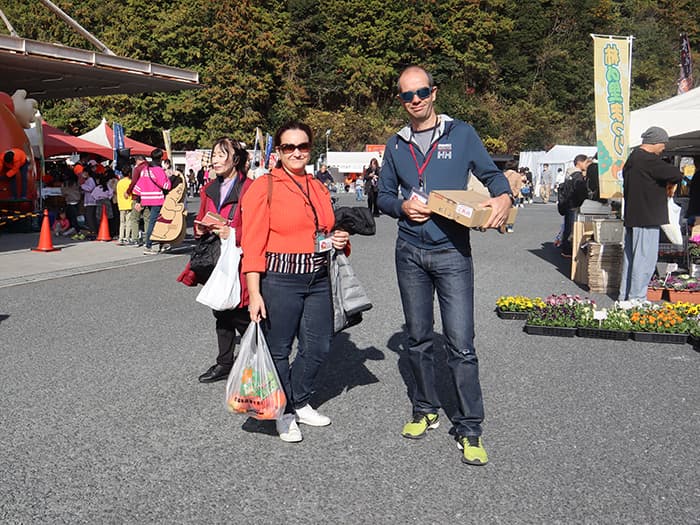
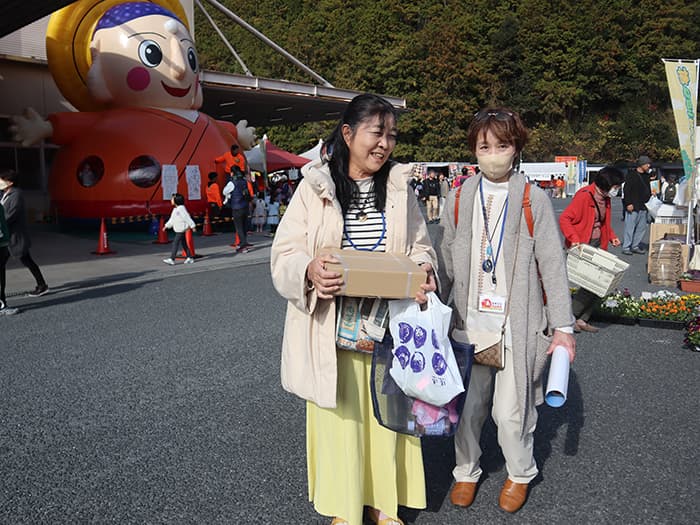
Enjoy a nutritious vegetable dish full of persimmons at the seasonal vegetable restaurant “Noyusha Ohindo”
“Noyusha Ohindo” is located near the top of a mountain in a satoyama village surrounded by plum fields and persimmon mountains in Yushio, Nishiyoshino Town. It was an old house with a magnificent gate that gave the impression of a wealthy farmer, as it is said to have been a hall where Emperor Go-Daigo, the Emperor of the Northern and Southern Courts, was sheltered.
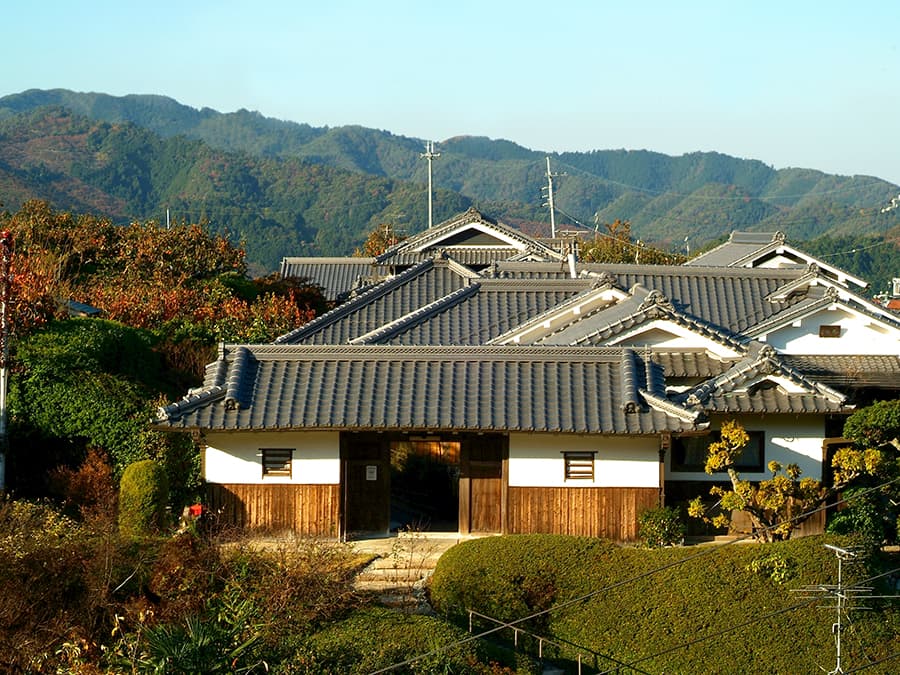
First, we had a persimmon harvesting experience at the Ohindo family’s persimmon field. We learned how to pick persimmons in the persimmon field in front of our house, and with scissors in hand, we searched for large, delicious-looking persimmons. Normally, the all-you-can-eat meal comes with a souvenir, but this year, due to the scorching heat, there aren’t many fruits, so each person has to take home three persimmons.
It would be a lie to say that it was not a bountiful harvest; to the untrained eye, the branches appeared to be laden with lots of fruit, and everyone was seriously picking them. Although it was the first time for many of them to pick persimmons, they were all smiling as they each got some nice persimmons.

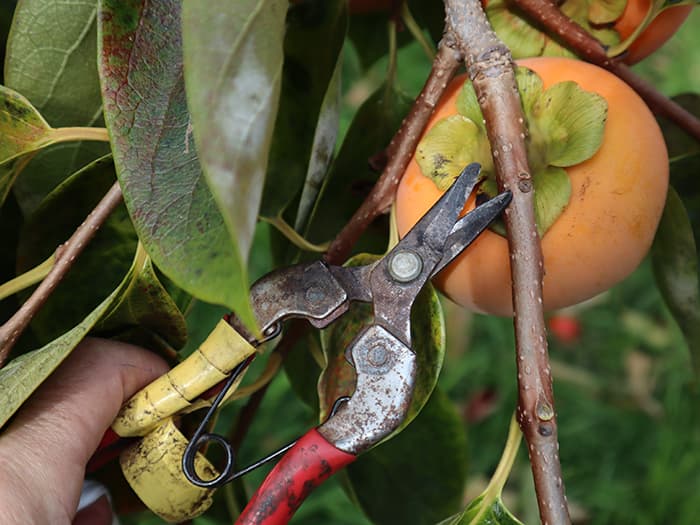

It’s finally the long-awaited lunch time. Enjoy your meal at a table set in a spacious Japanese-style space while looking out at the garden’s plants. At the restaurant, local mothers use seasonal ingredients to serve vegetable dishes that take advantage of the handmade knowledge passed down in the area. We also use additive-free seasonings, such as handmade miso, salt (sakura salt and plum salt), and plum sesame miso dressing.
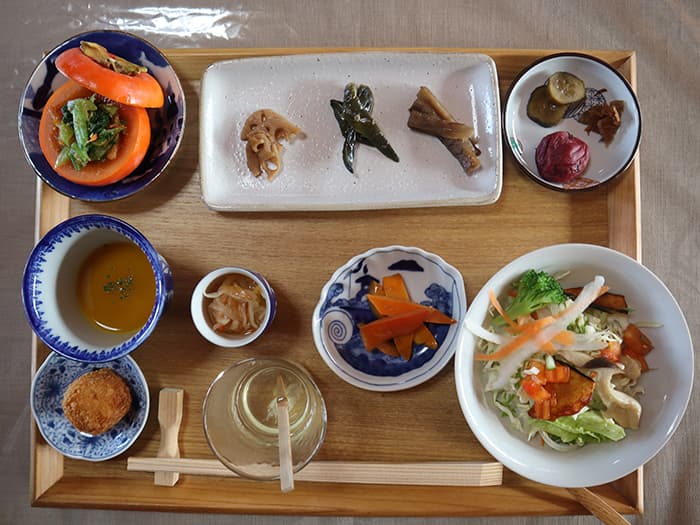

Three kinds of vegetables, soaked Yamato mana in a persimmon pot, persimmons, vegetable salad with persimmons, vegetable croquettes, pumpkin potage, vegetable tempura, miso soup, three kinds of pickles, wood-fired stove (bonfire stove) ) Shimeji rice cooked in Hagama was served freshly.
To finish off the meal, a peeled persimmon dessert and a light persimmon sweetness are served, making this a truly persimmon-filled lunch course. Many people expressed their admiration, such as, “The persimmon kinpira is surprising! This is truly SDGs♪”, “It’s my first time to have tempura with Yamato Tokiha leaves. It was delicious!”, and “The persimmon tempura is sweet and good!” Ta. Many people took a bite of the persimmon pot and finished it.
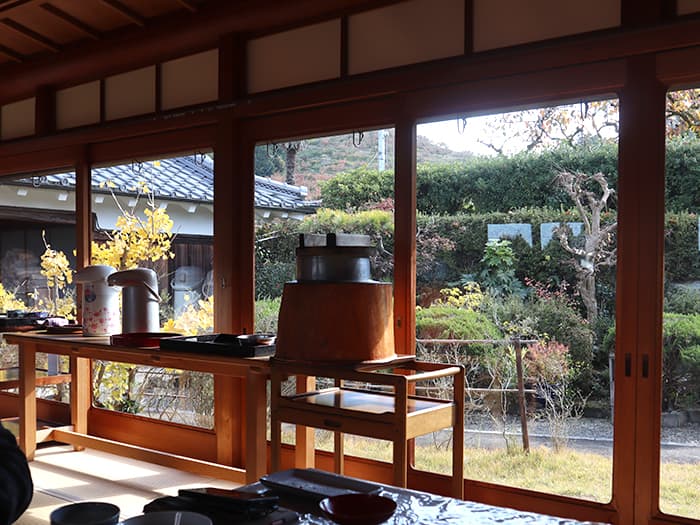
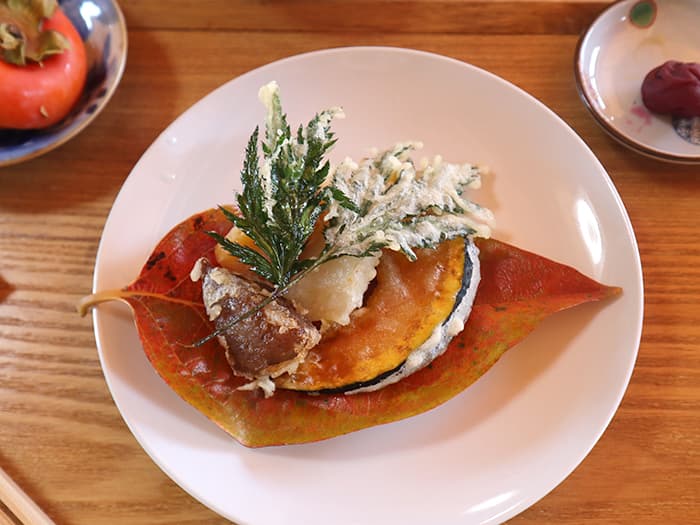

Gojo Sake Brewery Tour of ``Goshin'' - A flood of questions to the brewery owner. Tasting and shopping of various types including new sake
After enjoying a luxurious lunch, move from Nishiyoshino to the center of Gojo. I visited Gojo Sake Brewery, which is right near JR Gojo Station. Kazuyuki Mizukami of the Nara Prefecture Sake Brewers Association explains that this year marks the 100th anniversary of the sake brewery, which is known for its “Goshin” brand. Sake is an offering to the gods, and the name comes from the fact that it is brewed in Gojo.

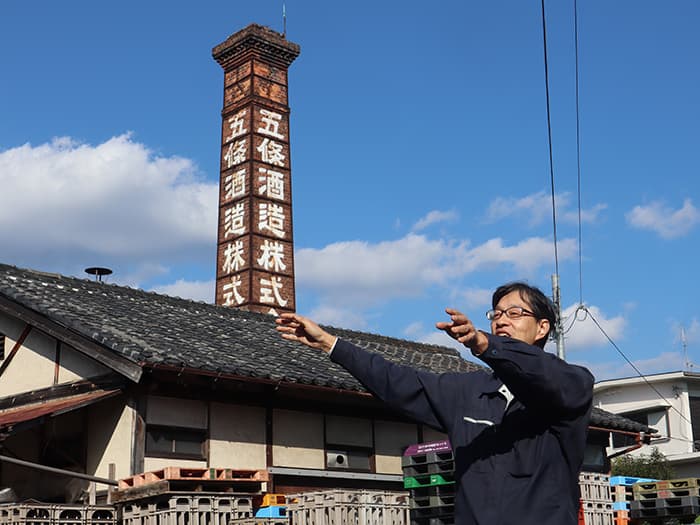
The brewery is handmade in the traditional Tajima style using clear underground water from Mt. Kongo. It is said that they produce mellow sake in small quantities. By the way, I learned that natto bacteria is the enemy of sake breweries. Preparation for this year’s sake has begun at the brewery, and in order to avoid invading germs from people’s hands, we listened to President Eiji Nakamoto’s story while peeking inside through the entrance.
The tour and tasting will be divided into two groups. Each team asked questions such as, “How long does the brewing process take?” “There was a scene in the morning drama “Ranman” about a sake brewery burning down. There were many questions, such as “Is there one thing that is green?”, and Mr. Nakamoto answered each one carefully.
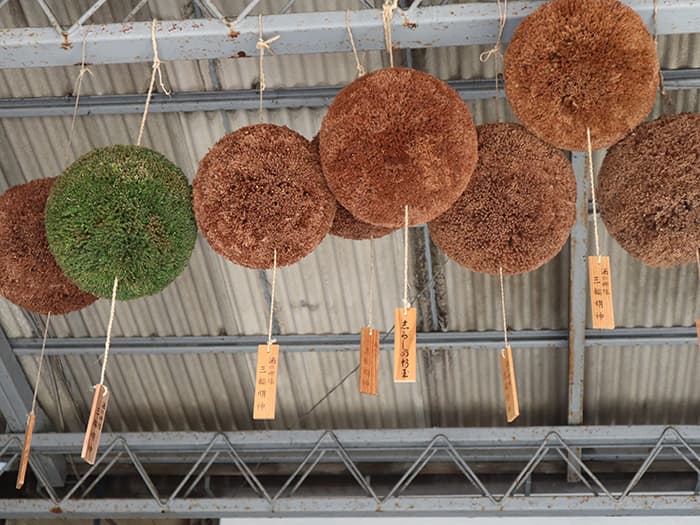

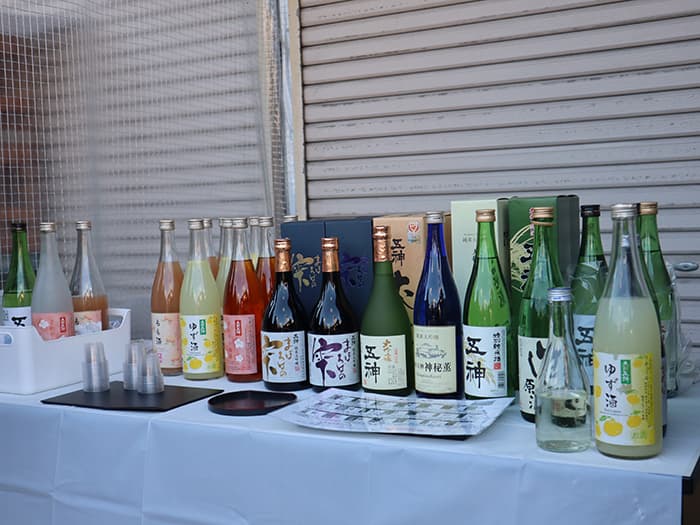
Alcohol is produced through two chemical changes: (1) saccharification of rice (starch) and (2) conversion of that sugar into alcohol.He explained that this is different from wine (single fermentation), and that the higher the quality of the sake, the more the rice is washed and squeezed. They said that each step of the process takes a lot of time and effort.
At the tasting spot, many of our own products are lined up, and guests are served drinks according to their tastes. Everyone was changing glasses and comparing drinks one after another. The French couple, who usually drink wine, said with great pleasure, “Sake is delicious.”
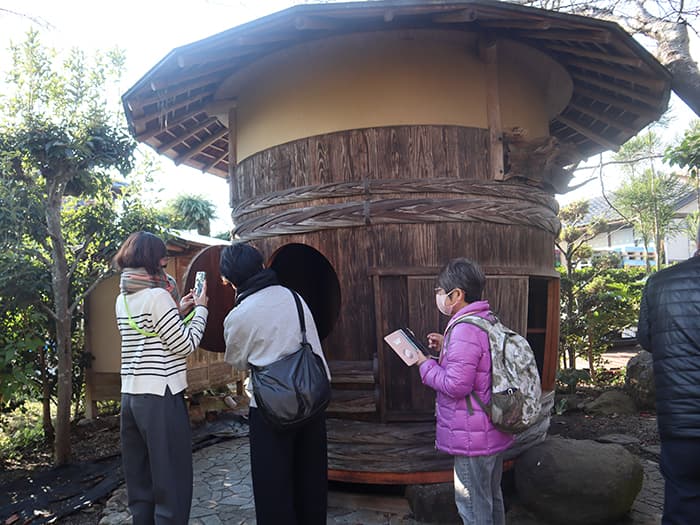

In the garden on the premises, there is an elegant tea ceremony room called “Kochuan”, which is made from a former cedar sake barrel, and we were able to see the inside through the nijiri-guchi and small windows. The tea room, which accommodates two people in addition to the host, has a fireplace, a small floor, and even a water stall, which foreign guests seemed to be particularly interested in.

Stroll along the quaint Gojo Shinmachi Street. To Gojo Genbei who received one Michelin star
Gojo Shinmachi Street developed as a castle town for the Gojo clan in the early Edo period, and is lined with buildings from that period. In 2010, it was designated as an important preservation district for groups of traditional buildings. While looking at the quaint townscape with interest, I headed to the restaurant Gojo Genbei, which could be called the main event venue. This is a famous restaurant that received one Michelin star in 2017.
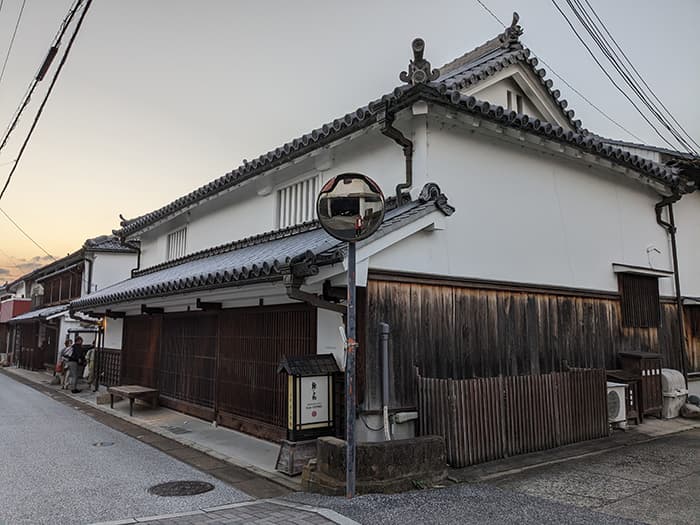
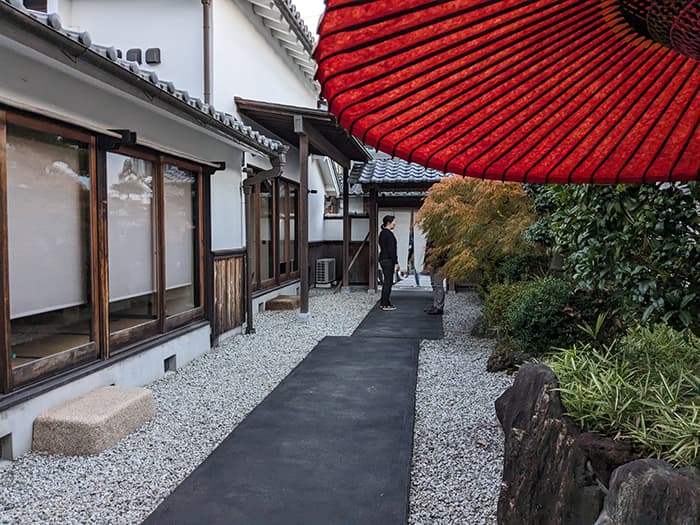
The store is a 250-year-old large merchant house that has been renovated into a Japanese restaurant. The owner and head chef, Akito Nakatani, focuses on the gojo vegetables, which are rich in flavor, and focuses on seasonal ingredients that complement each other, creating dishes that create new encounters. The head chef personally goes to the fields in the morning and consults with the vegetables that will be harvested that day to create a dish unique to that day.
Enjoy the charm of persimmons, the marriage of ingredients that create a synergistic effect, and the pairing with Gojo sake with all five senses.
Mr. Nakatani said, “Today is a gastronomy tour with the theme of persimmons, so we will combine the various charms of persimmons with vegetables to create dishes that tell a story.Enjoy pairing these dishes with sake. “I want you to enjoy it. Cooking should be entertainment,” he says, raising expectations for the upcoming performance.
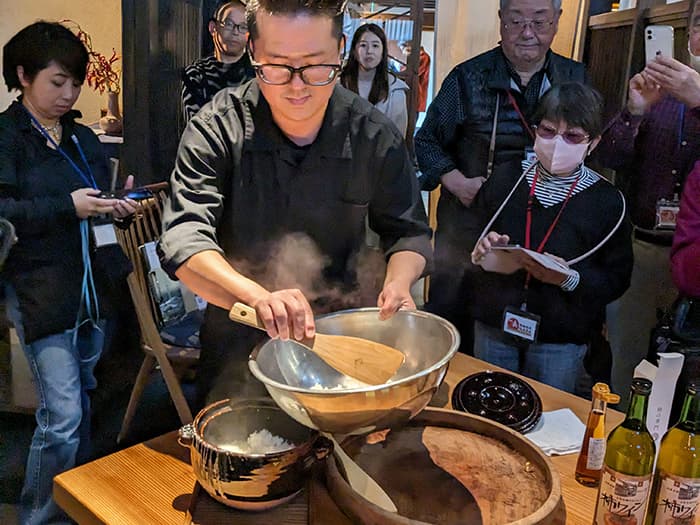

[Rice, persimmon vinegar, turnip + "persimmon wine"]
First, we tasted just the vinegared rice, which is made by mixing persimmon vinegar into freshly cooked rice, then we tried it again with thinly sliced turnips, and at the same time we tasted just the persimmon wine, and then we tasted the marriage of the food and the persimmon wine. The idea was to entertain the strange. Most people said, “Wow, the taste of persimmon wine has added depth!”
By the way, “Kaki Vinegar” is a product of “Persimmon Specialty Ishii” (Ishii Bussan Co., Ltd.) in Nishiyoshino, and “Kaki Wine” is a signature product of Yamamoto Honke Co., Ltd., also located on Gojo Shinmachi Street. President Kazuhiro Ishii, President Takashi Yamamoto, and Gojo Sake Brewery President Eiji Nakamoto also rushed in to greet the guests, and they enjoyed themselves while supporting Mr. Nakatani’s food amusement.
[Persimmon Narazuke, firm tofu, and herbs + “Goshin Junmai Ginjo Nama Genshu”]
Next up was a dish in which ultra-thin slices of “Persimmon Narazuke” from “Persimmon Specialty Ishii” were topped with firm tofu from a local tofu shop and garnished with Japanese pepper. The firm tofu is so smooth that it can be mistaken for silken silk, and the salty taste of the persimmon narazuke goes well together, with the bitterness and aroma of the Japanese pepper accentuating it. This is paired with “Goshin Junmai Ginjo Nama Genshu” (Gojo Sake Brewery). It seems to go well with strong alcohol.
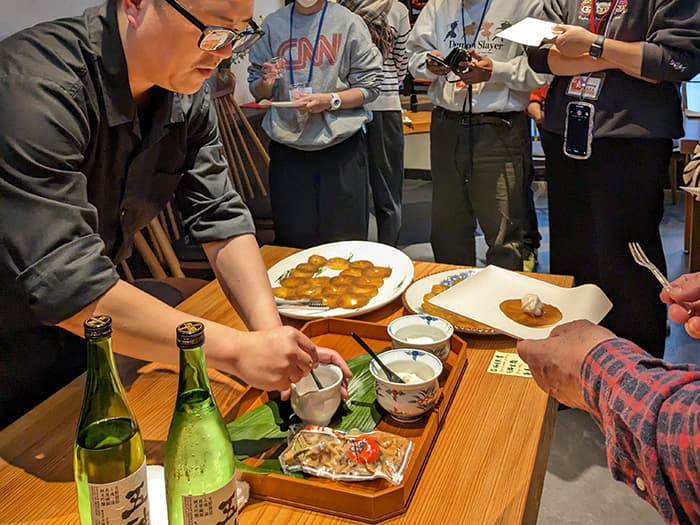
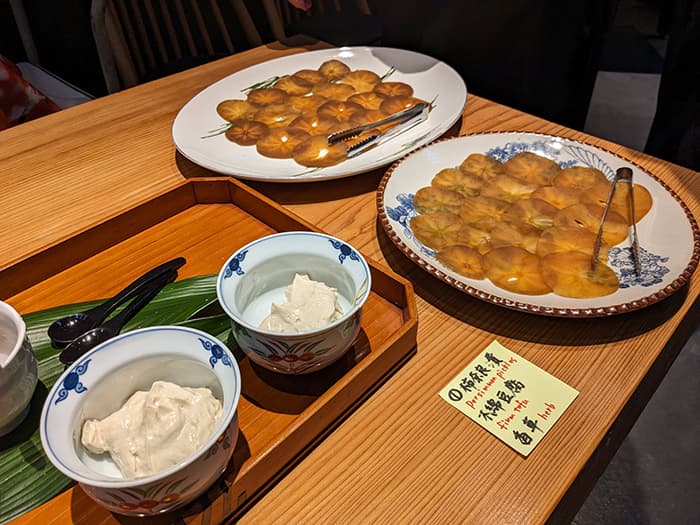
[Hime apple and cauliflower with dried persimmon slices & persimmon butter + “Tsuyuha Kaze”]
Grilled Hime apples and cauliflower topped with “persimmon chips” are arranged neatly in a fine makie lacquer box that gives you a sense of the history of a large merchant house, and is served with “persimmon butter.” Both “Dried Persimmon Slices” and “Persimmon Butter” are popular products from “Persimmon Specialty Ishii”. Persimmons go well with dairy products and protein, so I paired this with “Junmai Daiginjo Mahoroba no Shizuku/Tsuyuhakaze” (Gojo Sake Brewery).
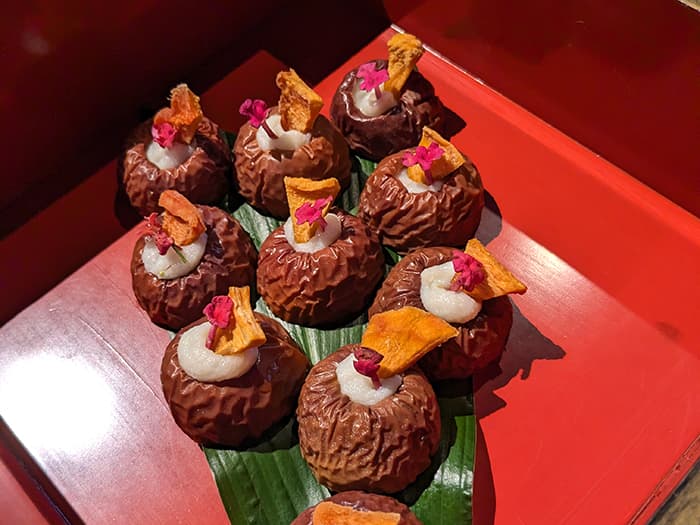
[Deer roast and persimmon jam + “Gin no Sato”]
Last but not least is Gojo Gibierre’s venison. It was a roasted deer that was cooked at a low temperature for 6 hours and topped with a bit of “persimmon jam” (Ishii, a persimmon specialty). Mr. Nakatani said, “The deer in Nara Park are sacred deer, but the deer in Gojo are pests that eat up the crops that farmers work hard to grow.So let’s eat those deer, and let people eat the delicious persimmons that those deer eat.” Let’s do it!” he exclaimed, exclaiming.
“Once you have chewed the venison more than 15 times, it will be delicious if you put “Junmai Daiginjo Ginnosato” (Gojo Sake Brewery) into your mouth,” he says, and recommends it to everyone.
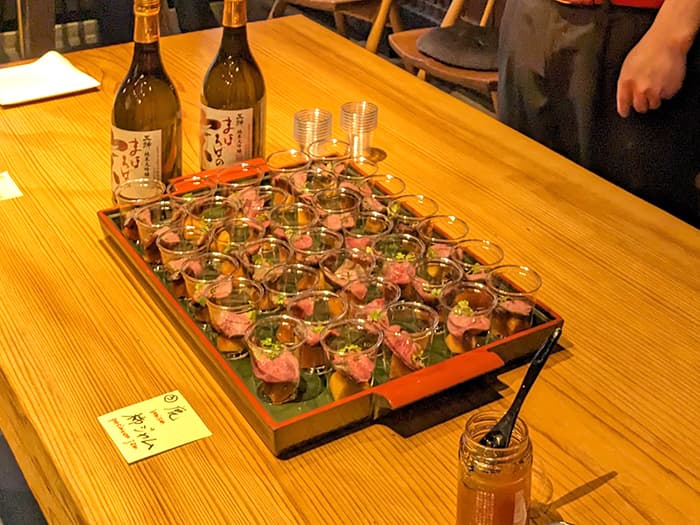
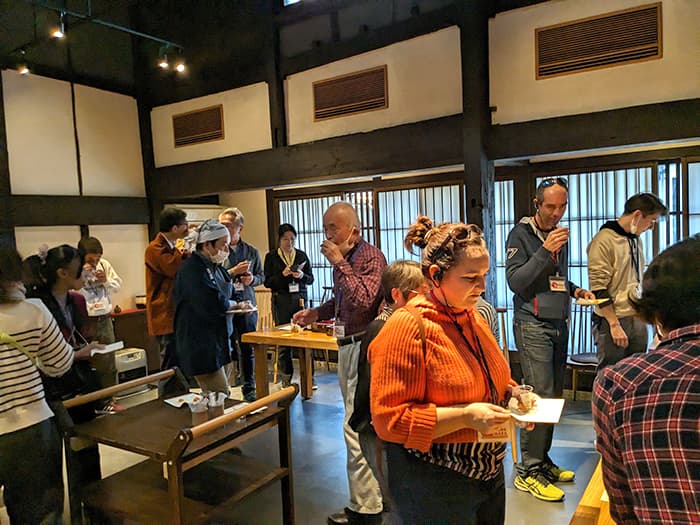
Many people said, “I’ve never had venison this delicious before,” and one person said, “It didn’t have any smell, and it was so soft that I didn’t have to chew it that much (lol).”
As the party drew to a close, Mr. Nakatani showed the pairing sheet and said, “Today’s sake pairing is my own, but you may prefer a different combination, so please write that down.” I urged. Each participant filled out a sheet or questionnaire while tasting the wine again with a serious look on their face.
A Chinese woman who usually drinks sake said, “I like persimmon wine♪” and was refilled with persimmon wine many times. The members spent eight hours together starting early in the morning, sharing food and interacting with each other, with one Taiwanese man saying, “I’d like to spend the night over and have some drinks, get to know each other more, and listen to the stories of the locals.” It was done.


Very happy with the variety of events! The surprise is an origami deer present♪
After leaving Genbei with regret, the tour passengers returned to the bus along Shinmachi Street, where dusk was beginning to dawn, and became the only people on board. As the bus started running, our interpreter guide, Ms. Matsumura, brought us a surprise. Each child was given a cute deer that she had folded out of chiyogami paper. Everyone had big smiles upon receiving this unexpected souvenir. I’m sure your Nara tour left a deeper impression. After that, of course, I fell asleep all the way to Kashihara-Jingumae Station, the disbanding place…
